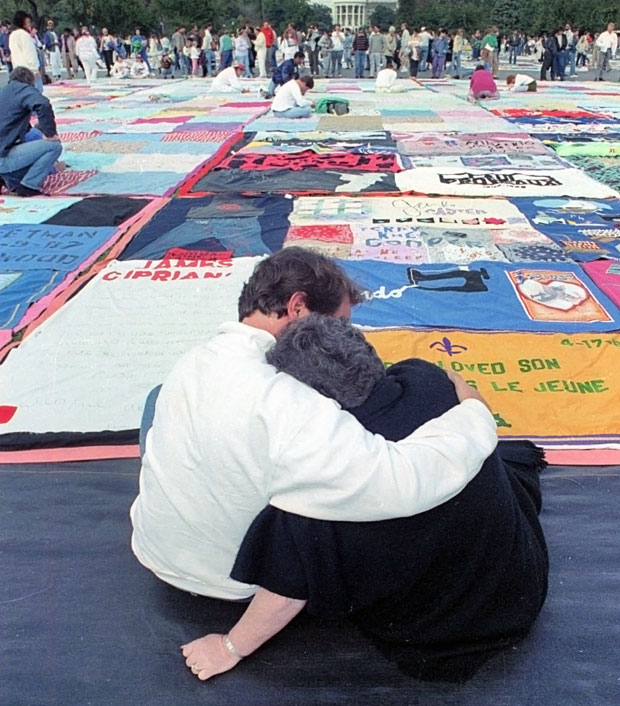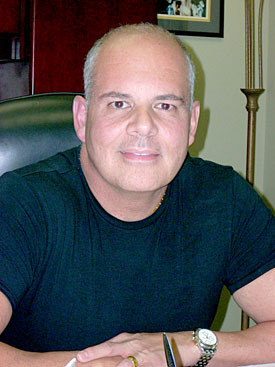Report that drug could protect HIV-negative men from infection is good news, but concerns remain over long-term effects, some say
David Taffet | Staff Writer taffet@dallasvoice.com

- REMEMBERING THEIR NAMES | Two unidentified visitors console each other at the NAMES Project AIDS Memorial Quilt display in October 1989 in Washington, D.C. Panels from the Quilt will be on display in the International Peace Chapel at Cathedral of Hope on World AIDS Day 2010, Wednesday, Dec. 1. More coverage of World AIDS Day events in North Texas begins on Page 14. (Doug Mills/Associated Press)

An extensive study released this week indicates that use of the anti-retroviral drug Truvada by HIV-negative men can prevent infection. Use of the drug for prevention is called Pre-Exposure Prophylaxis or PrEP.
Dr. Nick Bellos, a local infectious disease specialist, called the results of the study a step in the right direction. But Bellos also warned that the study only showed 75 percent effectiveness in preventing infection among people who were most compliant. And he said he had concerns about patients developing resistance to the drug and not using other risk-reduction techniques.
Local AIDS activist Bret Camp, associate executive director for health and medical services at Resource Center Dallas, also warned that the side effects and long-term effects of using Truvada can be severe.
Global HIV Vaccine Enterprise executive director Dr. Alan Bernstein, referring to another recent study using a topical microbicide that appears to prevent HIV infection in women and another study that included the first demonstration of efficacy by an HIV vaccine regimen, said, “The announcement [about Truvada] … is a very important addition to what is the most promising 15 months in the field of HIV prevention research since the epidemic began 27 years ago.”
The Centers for Disease Control said the findings in the Truvada study are a major advance in prevention research and a new tool to reduce the risk of infection among gay men and bisexuals.
Dr. Brady Allen, a Dallas internist, was optimistic, but also had some concerns.
“I think we have a lot of issues to consider with PrEP,” he said. “We will certainly need recommendations from the CDC. In addition, I think it is promising work.”
AIDS Arms Executive Director Raeline Nobles was also optimistic.
“This study shows hope and a new way to battle the HIV epidemic,” Nobles said. “Usually we are a little apprehensive when there is a press release about new drugs or vaccines being tested, as we know there will be years of further study and validation — and often failure over time to come to fruition.”
But, she added, the Truvada study has her excited about the future.
Camp stressed that “The anti-retroviral prophylaxis approach is promising but only a piece of the solution.”
He said that the new drug therapy cannot replace traditional prevention methods, and he pointed out that new infections did occur among men who took the medication.
Among the 2,500 enrolled participants, 36 new infections occurred among individuals who received the drug. Among placebo recipients, there were 64 new infections. Researchers estimated that the use of the preventive medication cut new HIV infections by an estimated 44 percent overall when compared to placebo.
“Adherence to taking the pills is key to success,” Camp said.
The study did show that those who took Truvada daily had a much higher rate of protection than those who took the pills only half of the time.
Camp said that “two participants who seroconverted had resistance after” that would have been built by irregular use of the drug, causing it to be at a lower-than-therapeutic level in the blood at the time of infection.
Bellos said that those patients also may have contracted a strain of the virus that is resistant to Truvada.
But Bellos still called the results promising and said that prophylaxis is a good idea.
“In a perfect world, if we could get everyone treated, we could plateau the epidemic,” he said.
While the CDC called “developing guidance on the safe and effective use of PrEP and determining how to most effectively use PrEP in combination with other prevention strategies to reduce new infections in the U.S.” its most urgent priority, Camp warned of the risks.
While he said that compared to some of the other anti-retrovirals on the market, Truvada is fairly well tolerated, it can still cause headaches, nausea and diarrhea.
“It’s known to cause decreases in renal function,” he said. “We could be setting people up for renal issues and the long-term effects are just now coming to our attention. Cardio-vascular disease, diabetes — we don’t know what the next 10 to 20 years on those drugs will be.”
Bellos noted that metabolic bone disease could also be an issue.
He said that anyone taking the drug as a prophylactic measure would need to be medically monitored on a regular basis, just as someone who is HIV-positive.
Despite his concerns, Camp did say he believes the results are a breakthrough that proved a non-intended use or expected finding. Previous studies have shown a benefit of drugs for medical personnel accidentally exposed to the virus but this was the first time prevention was proven through sexual exposure.
“The value is more in post-exposure, when traditional HIV prevention mechanisms fail,” he said.
Camp said he is more excited about the research into anti-microbial topical gels that have recently also proven effective in preventing infection after exposure.
Bellos agreed.
“My preference is for a vaccine,” Bellos said.
“Then we don’t have to worry about it.”
He said that a study has been done in South Africa among couples where one is HIV-positive and the other is negative, showing that when the positive partner’s viral load is undetectable, the risk to the negative partner is about 6 percent.
“On therapy, 94 percent of the negative partners stayed negative,” he said.
Bellos also warned that the Truvada study showed that even for the most compliant participants in the study showed only 75 percent effectiveness in preventing infection.
He said he is concerned that people will ignore traditional prevention methods that have proven effective and instead rely on the less-effective prophylaxis.
Nobles said it has long been known that strict adherence to anti-retroviral treatment among HIV-positive people leads to less transmission of the virus to others.
But she wondered about some of the ethical implications that need to be studied, including the cost and availability of Truvada.
“If we can’t afford to treat all HIV positive people living with the disease today — which we cannot — how will we ever be able to afford paying for preventive medications, too?” Nobles said.
The drug costs about $45 per pill in the United States. Because the manufacturer gave away the patent for production by generic drug makers in other countries, it is available in some countries for under $1.
“One wonders if insurance companies are going to be willing to pay for this,” Allen said.
Bellos said that he has some patients with family members in places like Pakistan and Thailand and they are able to get the drug from overseas.
“We should have two other large PrEP trials reported on in 2011 in other high-risk groups, which will help confirm or refute these results,” said Allen.
President Barack Obama also weighed in on the importance of the study.
“I am encouraged by this announcement of groundbreaking research on HIV prevention,” the president said in a statement released Tuesday, Nov. 23.
“While more work is needed, these kinds of studies could mark the beginning of a new era in HIV prevention,” the president said.
“As this research continues, the importance of using proven HIV prevention methods cannot be overstated.”
……………………..
MORE ON TRUVADA
Truvada is a combination drug therapy known as a nucleoside analog reverse transcriptase inhibitor. Two anti-HIV medications, Emtriva® and Viread®, are combined into one pill that is taken once a day with or without food.
In the United States, the cost of the treatment is more than $1,000 per month.
Manufacturer Gilead has given away the patent for generic manufacturers to produce and sell it in third world countries. There, the cost of the drug averages 45 cents a day or about $15 per month.
Those generic medications are not available in the United States.
Dr. Nick Bellos said that patients of his who have access to the generic medication have family members in those countries that are filling the prescription and sending them the drug.
Truvada has been one of the more successful HIV medications. Fewer people seem to experience side effects on this drug than on some of the others.
Studies show that more people became and stayed undetectable over a three-year period on Truvada than on Combivir or Sustiva, two other popular HIV medications.
Those on Truvada showed a greater increase in the number of CD4 cells than on other medications.
Side effects include nausea, vomiting, unusual muscle pain and/or weakness.
Longterm use could lead to liver damage, renal failure, increased risk of diabetes and metabolic bone disease.
Changes in body fat have been seen in some people taking Truvada.
—David Taffet
This article appeared in the Dallas Voice print edition November 26, 2010.















Its interesting news to hear, especially for us in subsaharan africa and zambia in particular.